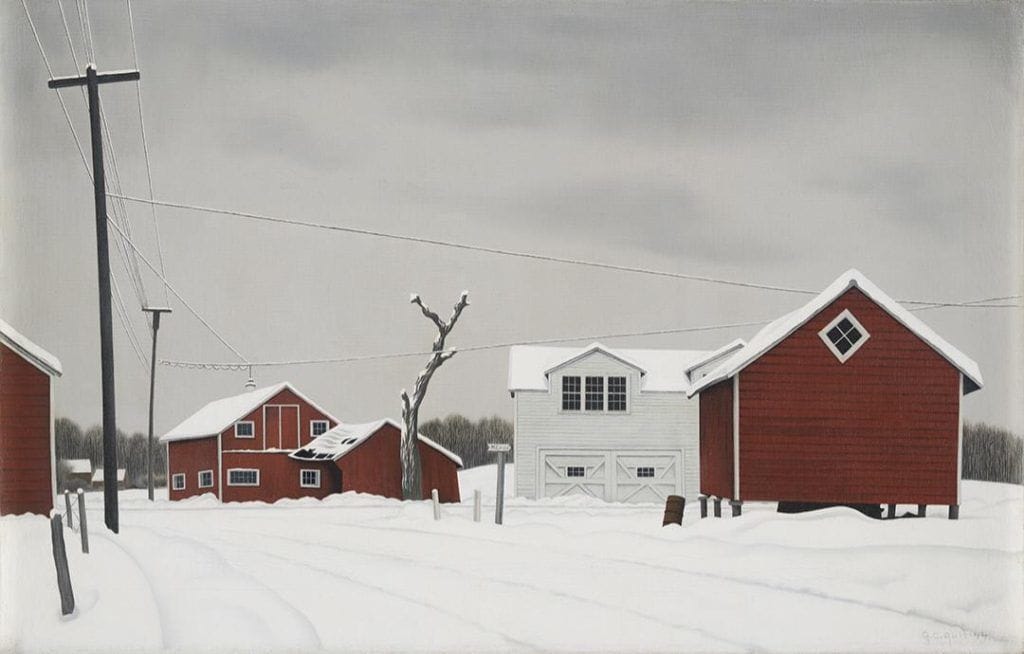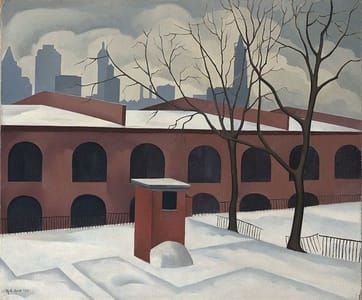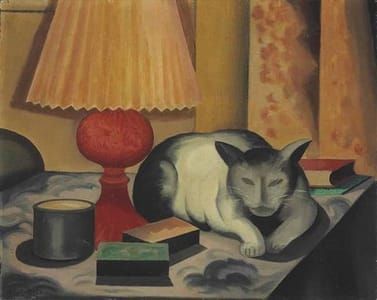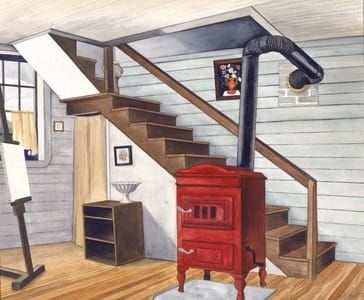

Daylight at Russell's Corners, 1944
George Copeland Ault
George Ault moved to Woodstock in 1937 and lived there until his untimely death by drowning at the age of 57. Ault had endured many hardships in his life, including the loss of his family’s fortune in the 1929 stock market crash. His mother died in a mental hospital, and the shock of Black Tuesday led to the suicides of his three brothers shortly afterward. These traumas in his personal life may have largely affected his increasingly strange and erratic behavior in the 1930s, combined with severe alcoholism, which eventually alienated most of his artist and dealer friends.
His retreat to Woodstock with his wife Louise signaled a fresh start in his life. Here, he and Louise enjoyed quiet walks throughout the countryside where, at a small intersection just outside town called Russell’s Corners, Ault found a subject that enthralled him for the rest of his life.
George Ault painted five pictures of Russell’s Corners during differing times of the day and year. The work featured in the Crystal Bridges collection is the sole piece depicting the scene during the daytime, the landscape beautifully covered in snow. He also captured the small collection of buildings from various angles, each one rendered in the style associated with Precisionist artists like Charles Sheeler and Ralston Crawford. After his death, his wife Louise said that this lonely intersection held some “mystical power” for the artist, and that painting these scenes, and Ault’s art in general, served as a way for him to make “order out of chaos.”
Ault’s death in 1948 was ruled a suicide by the coroner, and one can sense that the artist may have struggled with mental health issues that, for him in that time, felt beyond his control. His wonderfully controlled and detailed canvases of Russell’s Corners, however, will continue to enthrall viewers with its mystery, melancholy, and mystical quality.
[https://crystalbridges.org/blog/greetings-from-russells-corners-on-george-copeland-aults-birthday/]
George Copeland Ault moved to New York City from England in 1911 and soon after began painting urban cityscapes in a precisionist style. While his reductive aesthetic and highly controlled manner of execution is often associated with artists like Charles Sheeler and Ralston Crawford, Ault did not observe beauty in the effects of industrialization and the growth of the American city, once referring to New York City as “the Inferno without the fire.” In 1937 Ault moved with his wife, Louise, to Woodstock, New York where they avoided the artist’s community and instead lived modestly in solitude. The stark and figureless rural scenes he produced during this period attest not only to this reclusiveness but also to the preservationist conviction present in much of Ault’s body of work.
Ault executed five versions of the well-known Woodstock location known as Russell’s Corners between 1943 and 1948, using the location to explore relationships between geometric forms and linear patterns as both time and the seasons changed. Only a quarter mile from his studio, Russell’s Corners held a special intimacy for Ault and played a significant role in his artistic career. The present work is the only version depicting the agrarian scene in the daylight. Unlike the other nocturnal versions, Daylight at Russell’s Corners allowed Ault to depict the locale in heightened detail. The rich red hues of the barn contrast sharply against the stark tones of gray, as do the telephone poles and bare tree jutting out from the snow. The figureless scene powerfully evokes a sense of desolation and mystery that speaks to Ault’s interest in the work of Giorgio de Chirico and the Surrealists, with whom he began to engage during the mature period of his career.
[http://www.sothebys.com/en/auctions/ecatalogue/2015/american-art-n09425/lot.43.html]
Uploaded on by Suzan Hamer
George Copeland Ault
artistArthur
Wait what?





